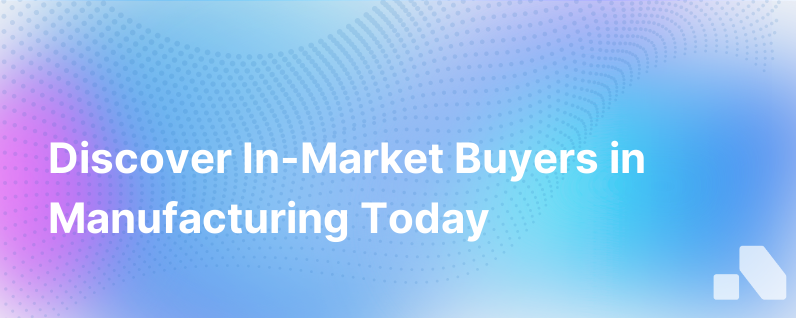
The manufacturing sector, with its sprawling ecosystem of vendors, suppliers, and buyers, operates on the symbiotic relationships between these entities. Yet, one of the most significant challenges manufacturing companies face is identifying 'in-market' buyers—those who are actively seeking the products and services your business provides. As the competitive landscape evolves and digital transformation reshapes the industry, traditional prospecting methods are no longer sufficient.
As a content marketer and SEO expert at Aomni, an AI platform for B2B sales, I've noticed that B2B manufacturing transactions are often complex, with longer sales cycles and multiple stakeholder involvement. Therefore, pinpointing buyers who are ready to engage, much less those poised to make a purchase, requires a calculated, multifaceted approach.
Understanding In-Market Buyers
In-market buyers are the subset of your target audience who have moved beyond the awareness and consideration phases and are actively comparing their options with an intention to purchase. They have recognized a need, researched potential solutions, and are evaluating providers that can meet their specific requirements.
Pinpointing these buyers involves understanding their buying journey and recognizing signals indicative of purchase readiness. These signals could range from the kind of content they're consuming, the search queries they’re using, to direct inquiries and engagement with your digital properties.
Leveraging Digital Footprints
Digitalization has left an indelible mark on the manufacturing buying journey. Buyers today leave countless digital footprints as they navigate the online landscape, providing vendors with opportunities to identify and engage them.
Content Marketing
Crafting detailed, informative, and SEO-optimized content is not only key to establishing thought leadership but also to capturing the attention of buyers who are seeking information relevant to their purchase decisions. From specialized blog posts and whitepapers to case studies and how-to guides, content can attract prospects at various stages of their buying journey.
Search Engine Optimization (SEO)
An astute SEO strategy puts your business in front of in-market buyers the moment they turn to search engines for solutions. Keyword research is pivotal to this process, identifying the terms and phrases buyers use when they are close to a purchasing decision.
Social Listening
Platforms like LinkedIn and Twitter can be powerful sources of insights into buyer behavior. Social listening tools track conversations around specific topics, products, or services related to your industry, highlighting potential in-market buyers expressing purchasing intent.
Utilizing Data and Predictive Analytics
Data analytics has become a cornerstone of modern manufacturing sales strategies. Through predictive analytics, you can harness historical data to forecast who might be looking for your products or services. AI platforms, such as Aomni, enhance this by delivering actionable insights and predictions on who your in-market buyers are likely to be, allowing your sales team to focus their efforts on the most promising prospects.
Account-Based Marketing (ABM)
ABM is a targeted strategy where marketing efforts are tailored to specific accounts that are identified as potential in-market buyers. This personalized approach not only increases engagement and conversion rates but also aligns sales and marketing efforts to deliver cohesive messaging.
Participation in Industry Specific Events and Trade Shows
Despite the rise of digital channels, there's still significant value in face-to-face interactions. Manufacturing trade shows and industry-specific events are critical gathering points for in-market buyers. Amidst product demonstrations and networking sessions, sales representatives have the opportunity to identify and interact with prospects who are there with the intent to learn, compare, and possibly purchase.
Hosting Webinars and Live Demonstrations
The immersive experience of live demonstrations and webinars provides a platform to showcase your products or services. They serve as prime opportunities to engage with participants who have shown enough interest to invest their time in learning about your offerings, signaling their position as potential in-market buyers.
Establishing Strong Relationships with Existing Clients
Referrals from satisfied customers are powerful endorsements that can directly connect you with in-market buyers. Nurturing relationships with your current customer base can open doors to new opportunities through word-of-mouth recommendations.
Following up with Leads who Re-Engage
Often, previous leads who did not result in a sale will re-engage with your content or salespeople when they are back in the market. Monitoring and following up with such leads can yield valuable in-market opportunities.
Conclusion
Identifying in-market manufacturing buyers is an intricate process that involves a blend of digital and traditional methods. The future of this challenge lies in leveraging AI-driven insights and predictive analytics to pinpoint purchasing intent, thereby streamlining the sales process and optimizing engagement.
Moreover, account-based marketing strategies and high-quality, relevant content coupled with robust SEO and SEM efforts can lead manufacturing vendors to the very doorsteps of buyers ready to make a purchasing decision.
And back at Aomni, this is what we excel at—delivering the tools you need for more strategic sales, including real-time account research, competitiveness insights, and personalized sales content. In the complex universe of manufacturing sales, we're dedicated to making sure that zero effort is required on your part to turn readiness into reality.